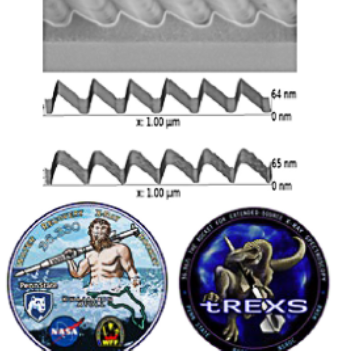
Randy McEntaffer
Professor
Education
- Ph.D. (2007) • Astrophysics • University of Colorado, Boulder
- M.S. (2002) • Astrophysics • University of Colorado, Boulder
- B.S. (2000) • Astronomy • University of Iowa
- B.S. (2000) • Physics • University of Iowa
Current Position
- Professor and Head, Department of Astronomy & Astrophysics, the Pennsylvania State University, University Park, PA
- I specialize in the design, fabrication, testing, and implementation of diffraction gratings for high throughput, high resolving power astrophysical observations. I study nanofabrication methodologies, alignment and testing of aligned grating modules, and the incorporation of grating modules into space-based spectrometers.

Top – Field Emission Scanning Electron Microscope (FESEM) image of a grating cross-section. This is a grating replica with ~160 nm period and 25ᵒ blaze in a sol-gel resist. Middle – Atomic Force Microscope (AFM) image of the same grating replica (upper middle) and a second AFM image showing the replica coated with 30 nm of Ni. Bottom – Mission patches for the Water Recovery X-ray Rocket (WRXR) and the Rockets for Extended-source X-ray Spectroscopy (tREXS), two NASA suborbital rocket missions utilizing diffuse X-ray spectrographs and PI’ed by McEntaffer.
Technology Interests
- X-ray and UV diffraction gratings
- Nanofabrication techniques: electron-beam lithography, dry etching, wet etching, deposition, grayscale lithography, thermal reflow, replication
- Alignment of optical systems especially reflection grating arrays and grating array to telescope mirror assembly
- Stress characterization in optical coatings
- Application of grating spectrographs in suborbital rocket missions with relevance to future strategic missions
Goals and Aspirations
- Continue to grow the next generation of professionals in our field through training and mentoring in an academic setting.
- Create new optics and methodologies that enable new science capabilities.
- Advocate for technology development funding given its importance in establishing university research groups and its substantial impact on training new researchers.
- Increase accessibility in our field through support and advocacy for traditionally underrepresented and underserved groups





























